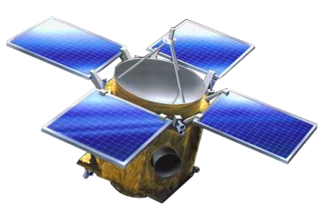
Near Earth Asteroid Rendezvous – Shoemaker, renamed after its 1996 launch in honor of planetary scientist Eugene Shoemaker, was a robotic space probe designed by the Johns Hopkins University Applied Physics Laboratory for NASA to study the near-Earth asteroid Eros from close orbit over a period of a year. It was the first spacecraft to orbit an asteroid and land on it successfully. In February 2000, the mission closed in on the asteroid and orbited it. On February 12, 2001, Shoemaker touched down on the asteroid and was terminated just over two weeks later.

The Pioneer Venus project was part of the Pioneer program consisting of two spacecraft, the Pioneer Venus Orbiter and the Pioneer Venus Multiprobe, launched to Venus in 1978. The program was managed by NASA's Ames Research Center.
High Energy Transient Explorer 1 (HETE-1) was a NASA astronomical satellite with international participation.
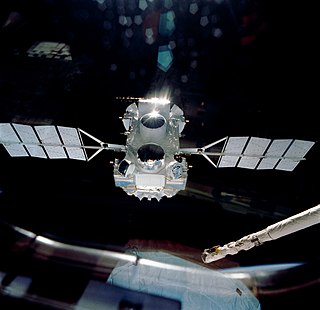
The Compton Gamma Ray Observatory (CGRO) was a space observatory detecting photons with energies from 20 keV to 30 GeV, in Earth orbit from 1991 to 2000. The observatory featured four main telescopes in one spacecraft, covering X-rays and gamma rays, including various specialized sub-instruments and detectors. Following 14 years of effort, the observatory was launched from Space Shuttle Atlantis during STS-37 on April 5, 1991, and operated until its deorbit on June 4, 2000. It was deployed in low Earth orbit at 450 km (280 mi) to avoid the Van Allen radiation belt. It was the heaviest astrophysical payload ever flown at that time at 16,300 kilograms (35,900 lb).

The Venera 11 was a Soviet uncrewed space mission which was part of the Venera program to explore the planet Venus. Venera 11 was launched on 9 September 1978 at 03:25:39 UTC.

The Venera 12 was an uncrewed Soviet space mission designed to explore the planet Venus. Venera 12 was launched on 14 September 1978 at 02:25:13 UTC.

Venera 13 was part of the Soviet Venera program meant to explore Venus.

Venera 14 was a probe in the Soviet Venera program for the exploration of Venus.
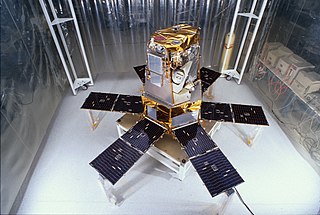
The Solar Radiation and Climate Experiment (SORCE) was a NASA-sponsored satellite mission that measured incoming X-ray, ultraviolet, visible, near-infrared, and total solar radiation. These measurements specifically addressed long-term climate change, natural variability, atmospheric ozone, and UV-B radiation, enhancing climate prediction. These measurements are critical to studies of the Sun, its effect on the Earth's system, and its influence on humankind. SORCE was launched on 25 January 2003 on a Pegasus XL launch vehicle to provide NASA's Earth Science Enterprise (ESE) with precise measurements of solar radiation.
Kosmos 111, E-6S No.204, was the first Soviet attempt to orbit a spacecraft around the Moon. The design was similar to the future successful Luna 10 spacecraft. Kosmos 111 was produced in less than a month, one of two spacecraft developed from the E-6 lander bus in a crash program to upstage America's Lunar Orbiter series and to commemorate the 23rd Congress of the Communist Party of the Soviet Union (CPSU), held in March 1966.
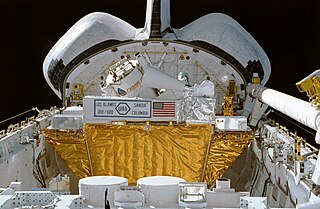
AFP-675 was a Space Shuttle experiment package that was carried into orbit on Discovery as part of STS-39.
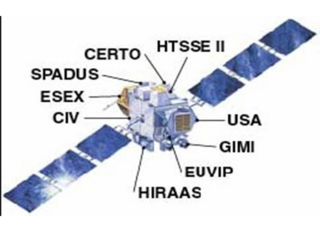
The Advanced Research and Global Observation Satellite (ARGOS) was launched on 23 February 1999 carrying nine payloads for research and development missions by nine separate researchers. The mission terminated on 31 July 2003.
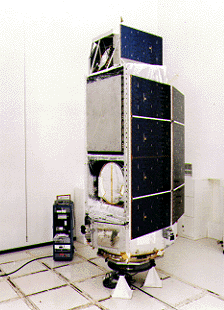
The last of NASA's three High Energy Astronomy Observatories, HEAO 3 was launched 20 September 1979 on an Atlas-Centaur launch vehicle, into a nearly circular, 43.6 degree inclination low Earth orbit with an initial perigeum of 486.4 km. The normal operating mode was a continuous celestial scan, spinning approximately once every 20 min about the spacecraft z-axis, which was nominally pointed at the Sun. Total mass of the observatory at launch was 2,660.0 kilograms (5,864.3 lb).
The High Energy Astronomy Observatory Program was a NASA program of the late 1970s and early 1980s that included a series of three large low-Earth-orbiting spacecraft for X-ray and Gamma-Ray astronomy and Cosmic-Ray investigations. After launch, they were denoted HEAO 1, HEAO 2, and HEAO 3, respectively. The large (~3000 kg) satellites were 3-axis stabilized to arc-minute accuracy, with fixed solar panels. All three observatories were launched from Cape Canaveral, Florida on Atlas-Centaur SLV-3D launch vehicles into near-circular orbits with initial altitudes slightly above 500 km.

OSO 7 or Orbiting Solar Observatory 7, before launch known as OSO H is the seventh in the series of American Orbiting Solar Observatory satellites launched by NASA between 1962 and 1975. OSO 7 was launched from Cape Kennedy on 29 September 1971 by a Delta N rocket into a 33.1° inclination, low-Earth orbit, and re-entered the Earth's atmosphere on 9 July 1974. It was built by the Ball Brothers Research Corporation (BBRC), now known as Ball Aerospace, in Boulder Colorado.

An X-ray astronomy satellite studies X-ray emissions from celestial objects, as part of a branch of space science known as X-ray astronomy. Satellites are needed because X-radiation is absorbed by the Earth's atmosphere, so instruments to detect X-rays must be taken to high altitude by balloons, sounding rockets, and satellites.

The history of X-ray astronomy begins in the 1920s, with interest in short wave communications for the U.S. Navy. This was soon followed by extensive study of the earth's ionosphere. By 1927, interest in the detection of X-ray and ultraviolet (UV) radiation at high altitudes inspired researchers to launch Goddard's rockets into the upper atmosphere to support theoretical studies and data gathering. The first successful rocket flight equipped with instrumentation able to detect solar ultraviolet radiation occurred in 1946. X-ray solar studies began in 1949. By 1973 a solar instrument package orbited on Skylab providing significant solar data.
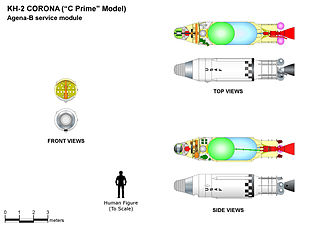
Discoverer 18, also known as Corona 9013, was an American optical reconnaissance satellite launched on 7 December 1960 at 20:24:00 GMT. It was the first successful, and the third of ten total Corona KH-2 satellites, based on the Agena-B.

Solrad 10, also known Explorer 44, NRL-PL 165 and Explorer SE-C, was one of the SOLRAD series designed to provide continuous coverage of wavelength and intensity changes in solar radiation in the UV, soft and hard X-ray regions. The satellite also mapped the celestial sphere using a high-sensitivity X-ray detector. Information collected was expected to contribute to a better understanding of the physical processes involved in solar flares and other solar activity, and the potential effects of this activity on short-wave communications, as well as on future human space travel. For the period of July 1971 to June 1973, the core memory data of Explorer 44 were used rather than those from Explorer 37. The Explorer 44 core memory failed on 11 June 1973, and Explorer 37 was heavily used until 25 February 1974, when the gas supply of the attitude control system was exhausted.
















